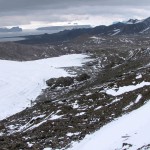Asked by Aaron
What a great question! One landform in Antarctica that might change over coming years is ice-cored moraines. These moraines have a core of remnant glacier ice; as this ice melts, the moraines downwaste. The meltwater provided by the melting glacier ice mobilises the sediment, resulting in slurrys, mass movements and slides. Because the moraines have only a thin surficial sediment thickness, they have a low preservation potential and once the ice melts away entirely, there may be little surface expression of the landform.
James Ross Island has several small cirques surrounded by large ice-cored moraines. Currently, these ice-cored moraines have multiple sharp-crested ridges, numerous small lakes and ponds, and surficial sediments ranging from sandy boulder gravel through to openwork basalt boulders and diamicton. Exposures show stratified ice (layered blue, white, bubble-poor and bubble-rich ice), sometimes with debris in.
The rate at which the ice is melting has not been precisely measured on James Ross Island. Once the debris cover reaches sufficient thickness (after enough debris-bearing glacier ice has melted), the debris will insulate and protect the glacier ice, which may eventually limit further moraine degradation.















